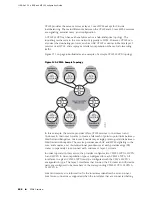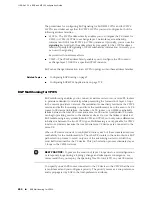
to all other RR clients even though only one of these routes is used to trigger the
VPWS pseudowire to the multihomed site.
Selecting the Designated VE Device for a Multihomed Site
BGP on each PE router in the VPWS network determines the best path to the
multihomed site by comparing path attributes. The PE routers receiving the advertised
routes first run the standard BGP selection process. The routes from the connected
multihomed PE routers all share the same site ID, but can have different route
distinguishers and block offsets; the routers are advertising different prefixes. The
following sequence is applied to all routes on a per-prefix basis:
1.
Select a path with a reachable
next hop
.
2.
Select the path with the highest
weight
.
3.
If path weights are the same, select the path with the highest
local preference
value.
4.
Prefer locally originated routes (network routes, redistributed routes, or aggregated
routes) over received routes.
5.
Select the route with the shortest
AS-path
length.
6.
If all paths have the same AS-path length, select the path based on
origin
: IGP is
preferred over EGP; EGP is preferred over Incomplete.
7.
If the origins are the same, select the path with lowest
MED
value.
8.
If the paths have the same MED values, select the path learned by means of
EBGP over one learned by means of IBGP.
9.
Select the path with the lowest IGP cost to the next hop.
10.
Select the path with the shortest route reflection cluster list. Routes without a
cluster list are treated as having a cluster list of length 0.
11.
Select the path received from the peer with the lowest BGP router ID.
12.
Select the path that was learned from the neighbor with the lowest peer remote
address.
The result of this process is the best path to the multihomed customer site through
each PE router connected to the site. One best path is selected for each router. The
process establishes whether the route advertised by each PE router is suitable for
advertising to peer routers.
Next, BGP runs the layer 2 multihoming selection process on this set of best paths
to determine the one best path the the customer site. The result of this process
establishes that the best path is suitable for establishing a pseudowire from the remote
PE router to the PE router. That PE router is accordingly selected as the designated
VE device.
The multihoming selection process is similar to the standard BGP process, but it
omits two steps:
■
The process does not prefer locally originated routes. Local origination is of no
value in establishing the designated VE device. The PE routers connected to the
customer site always have a local route and therefore all advertise a
652
■
BGP Multihoming for VPWS
JUNOSe 11.1.x BGP and MPLS Configuration Guide
Summary of Contents for BGP
Page 6: ...vi ...
Page 8: ...viii JUNOSe 11 1 x BGP and MPLS Configuration Guide ...
Page 37: ...Part 1 Border Gateway Protocol Configuring BGP Routing on page 3 Border Gateway Protocol 1 ...
Page 38: ...2 Border Gateway Protocol JUNOSe 11 1 x BGP and MPLS Configuration Guide ...
Page 234: ...198 Monitoring BGP JUNOSe 11 1 x BGP and MPLS Configuration Guide ...
Page 236: ...200 Multiprotocol Layer Switching JUNOSe 11 1 x BGP and MPLS Configuration Guide ...
Page 542: ...506 Monitoring BGP MPLS VPNs JUNOSe 11 1 x BGP and MPLS Configuration Guide ...
Page 544: ...508 Layer 2 Services Over MPLS JUNOSe 11 1 x BGP and MPLS Configuration Guide ...
Page 610: ...574 Virtual Private LAN Service JUNOSe 11 1 x BGP and MPLS Configuration Guide ...
Page 624: ...588 VPLS References JUNOSe 11 1 x BGP and MPLS Configuration Guide ...
Page 680: ...644 Virtual Private Wire Service JUNOSe 11 1 x BGP and MPLS Configuration Guide ...
Page 724: ...688 Monitoring MPLS Forwarding Table for VPWS JUNOSe 11 1 x BGP and MPLS Configuration Guide ...
Page 725: ...Part 6 Index Index on page 691 Index 689 ...
Page 726: ...690 Index JUNOSe 11 1 x BGP and MPLS Configuration Guide ...
















































